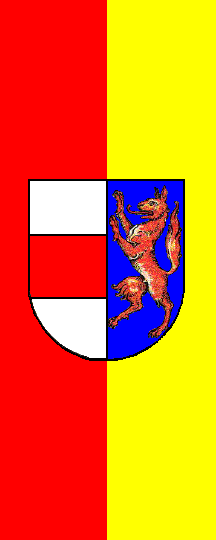 by
Ivan Sache
by
Ivan Sache
Last modified: 2014-04-11 by rob raeside
Keywords: niederoesterreich | lower austria | sankt poelten | wolf | bicolour: red-yellow |
Links: FOTW homepage |
search |
disclaimer and copyright |
write us |
mirrors
Sankt Pölten is a city of more than 50,000 inhabitants, capital city of the Land of Lower Austria (Niederösterreich) since 1986.
The old city of Sankt Pölten was built on the site of the ancient Roman city of Cetium. Emperor Hadrian (76-138; Emperor 117-138) made of Cetium a "municipium aelium" (municipal seat) in 121 or 122. The city was abandoned by the Romans in 400. In 1159, Bishop Konrad von Passau gave to Sankt Pölten the earliest municipal rights in Austria. The city was made a Princely city around 1490. New arms were granted to Sankt Pölten in 1538 by King Ferdinand I (1503-1564, King, 1521-1564). In 1785, Sankt Pölten became an episcopal city. The city was occupied by the French troops in 1805, and Emperor Napoléon I visited the city twice in 1809.
Around 40% of the city was destroyed during the Second World War and rebuilt after 1945. The population threshold of 50,000 was reached in 1972. Sankt Pölten was granted the title of European city in 1995.
The movie director and actor Bernhard (Bernd) Wicki (1919-2000) was born in Sankt Pölten. Wicki directed the movie "The Bridge" ("Die Brücke", 1959), portraying children in a village abandoned by the adults during the progress of the Allied troops in Austria. Wicki also directed the German scenes in Darryl F. Zanucks' "The Longest Day" (1962). He played as an actor under the direction of M. Antonioni ("La Notte", 1960), P. Handke ("Die linkshändige Frau, 1977), B. Tavernier ("La mort en direct", 1980), R. Dembo ("La diagonale du fou", 1984) and W. Wenders ("Paris, Texas", 1984). Two years ago, the French novelist Michel Quint portrayed Bernd Wicki in his wonderful book "Effroyables jardins" ("In Our Strange Gardens) and dedicated the book to him.
The flag of Sankt Pölten is vertical, vertically divided red-yellow with the coat of arms in the middle. The coat of arms is "per pale, silver a fess gules, azure a wolf proper".
The flag can be seen behind the Mayor of Sankt Pölten on the municipal website http://www.st-poelten.gv.at
From that image, it is not possible to guess the proportions of the flag and the vertical location of the coat of arms. I used a default 5:2 proportion and centered the coat of arms. The basis for the coat of arms is Ralf Hartemink's website.
Ivan Sache, 7 July 2003
The animal in question is a wolf, according to J. Louda's "Blasons des villes d'Europe" ("European Civic Coats of Arms"). According to the author, the wolf was taken from the Passau arms as Sankt Pölten was a fief of the bishops of that city; in 1538, they received their present form. Passau has argent, a wolf rampant gules. It must be said that the St Pölten wolf, as illustrated, is a rather foxy one!
Jan Mertens, 7 June 2003